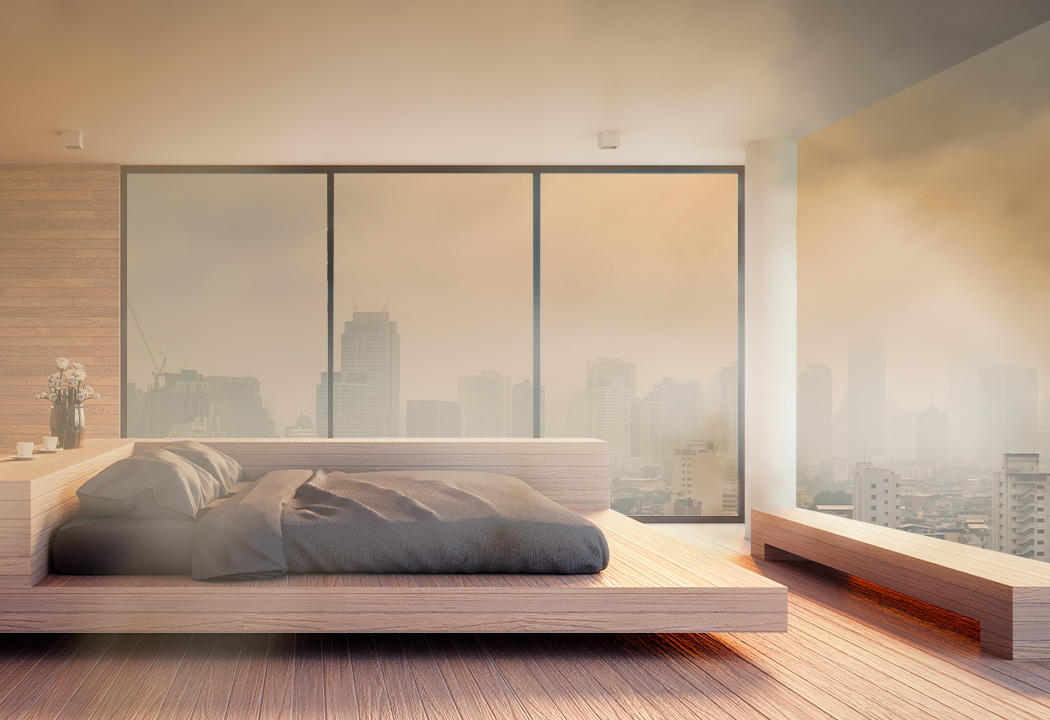Poor air quality in cities, but we breathe the worst air indoors

| The future of air quality: purifiers and innovation |
Explore the latest technologies and trends in air purification showcasing how Clivet is driving innovation in the sector.
One of the many problems troubling the Old Continent is air sickness. Although deaths in EU countries attributable to fine particulate matter (PM2.5) fell by 41% between 2005 and 2021, air pollution continues to be the most important environmental health risk for Europeans. It is no coincidence that, according to the latest estimates of the European Environment Agency, at least 253,000 people lost their lives in 2021 from exposure to fine particulate matter values higher than those recommended by the World Health Organisation (5 µg/m3). Not only that: it is alleged that nitrogen dioxide (NO2) pollution has caused more than 52,000 deaths, in addition to approximately 20,000 deaths from short-term exposure to ozone.

According to researchers from the Global Health Institute in Barcelona, who have estimated the annual mortality rate from air pollution (PM2.5 and NO2) in 1,000 European cities, Italy is among the countries most at risk when it comes to deaths linked to fine particulate matter. Besides Brescia, which is ranked top of the class, there are 25 Italian cities in the Top 50, including Milan (13th), Venice (23rd) and Turin (27th). The other countries with the most representatives are Poland, the Czech Republic, Hungary, Slovakia and Greece. On the other hand, the scenarios change when considering mortality linked to nitrogen dioxide pollution. The frontrunner in this case is the Spanish capital Madrid, followed by Antwerp, Turin, Paris, Milan and Barcellona. Germany, despite only having Herne in the Top 10, has 14 cities in the Top 50, closely followed by France, Italy and the Netherlands with 11, 8 and 7 representatives.

When we talk about polluted air, we almost always refer to the air we breathe outdoors, but actually, indoor pollution also deserves a lot of attention. In fact, as confirmed by the recent Air Quality Connected Data survey, in which indoor air quality data from 2.5 million purifiers in the world’s main countries were examined, overall between 2022 and 2023 the indoor air was found to be more polluted than outdoor air for more than 6 months a year.
According to the survey, the worst results were those obtained from China, Australia, France, Austria, Canada and Spain, which all recorded indoor PM2.5 levels higher than outdoor levels every single month in 2022, followed by Great Britain and Germany, which experienced worse air for 11 months. Only in homes in India, Poland and Finland was the level of fine particulate matter generally lower than the outdoor level, exceeding it by less than 6 months in 2022.
However, if we look at individual cities, top of the class for indoor pollution goes to the city of Milan. The average annual indoor PM2.5 levels in the Lombardy capital in 2022 were in fact 2.63 times higher than the outdoor levels. Closely behind Milan is China’s Shenzhen (indoor PM2.5 is 97% higher than outdoor values), Amsterdam (76%), Seoul (53%), Madrid (50%), Melbourne (40%), Vienna (37%), Singapore (36%), New York (35%) and Tokyo (24%). Tra tutte le città prese in considerazione dal sondaggio, soltanto 8 vedono livelli di PM2,5 indoor più alti di quelli outdoor per tutti i 12 mesi dell’anno: Shenzhen, New York, Melbourne, Milano, Roma, Seoul, Vienna e Amsterdam.
As revealed by numerous European surveys, the population of urban centres spends the vast majority of its time (about 95%) indoors, half of it in their own homes. This is why drawing attention to indoor pollution and the negative effects that poor air quality can have on the human organism is more urgent than ever. The risk of exposure not only concerns the largest part of the population, but is even more serious for some specific categories of people, such as the elderly, children and the chronically ill, who spend even more time indoors.
Consequences of indoor pollution on health
But what are the most common illnesses that can result from exposure to the main pollutants in indoor air? Some of them, such as passive smoking and combustion products, lead to an increase in the occurrence of chronic respiratory diseases, cardiovascular diseases, asthma and allergies. Others are known to increase the occurrence of tumours, while some organic compound mixtures may cause subclinical effects to the nervous system, leading to changes in behaviour and performance.
Not only that: another problem concerns the lack of knowledge about the substances that can be released over time by the materials used in buildings and their possible negative impact on health. An example? Hundreds of chemical compounds are used in the construction industry at high doses that are released into the air and subsequently come into contact with the people in the building and are absorbed by the body.

The quality of the air we breathe is also crucial for athletes, since during anaerobic training the respiratory rate increases significantly. Therefore, if the air is not pure, pollutants and fine dust particles enter the body, which can have harmful consequences on both health and performance.
Hence it is no surprise that the medical staff of AC Milan chose to equip the gym where the “Primavera” team trains with a complete air conditioning system that ensures an optimal temperature all year round and excellent air quality.
The air quality inside the gym is ensured by the Clivet Zephir 3 stand-alone heat pump system for air renewal and purification, thanks to its unique feature of renewing the air without contamination between the various flows and its high filtering efficiency with electronic filters. A system that is also a sustainable investment because it guarantees to cut primary energy consumption by 50% and reduce CO2 by more than 50%.
This website uses cookies, including third party ones, to enable website operations, for statistics, to improve your navigation experience and personalise the communications sent to you. You may accept these cookies by clinking on “Accept all” or clicking on “Preferences" to personalise your choices. On closing the banner without accepting, the website will only use technical cookies (needed for the website to operate).
For more information, even on single cookies, please read our cookie policy and our privacy circular.

 United Arab Emirates
United Arab Emirates  +971 (0) 4501 5840
+971 (0) 4501 5840  info@clivet.ae
info@clivet.ae  France
France  Germany
Germany  +49 40 325957-190
+49 40 325957-190  United Kingdom
United Kingdom  India
India  Russia
Russia  South East Europe
South East Europe 



